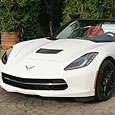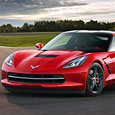
[an error occurred while processing this directive]
There may never be another American car with the history or iconic influence as the Chevrolet Corvette. What began as a fiberglass-bodied sports car that reflected the American attitude of the 1950’s survived the tumultuous business of the auto industry and evolved into the truly world-class sports car we see today. It is such a part of Americana that it even has its own museum; something no other single sports car model can claim.
How It Began
The first Corvette was the brainchild of GM designer Harley Earl in 1951 as an American answer to Jaguar, Austin-Healey, Ferrari and Alfa Romeo. The first Corvettes rolled off a Flint, Michigan assembly line at the end of June of 1953. All were white convertibles with black tops and red interiors, and only 300 were produced that first year. The sole powertrain was a straight-six cylinder engine mated a two-speed automatic transmission. Production increased ten-fold for the next model year but sales lagged as these early cars did not live up to performance expectations. By then, an engineer named Zora Arkus-Duntov was hired to work on Corvette and would later become its first chief engineer. When GM considered cutting the Corvette entirely, Duntov convinced management that ending the Corvette after such a short run would be an admission of failure. Duntov spearheaded improvements to increase performance and desirability and demonstrated the Corvette’s those results in time trial competitions while supporting the engineering efforts of other racers. Racing success along with styling and engineering changes had re-ignited Corvette sales and saved it from being an early memory of automotive history.
What A Catch!
Bill Mitchell succeeded Harley Earl as the General Motors styling chief and was an avid deep-water fisherman. Therefore, it’s no surprise that the shapes and colorings of his catches were adapted to what was drawn up in the studio. The 1959 Sting Ray Racer concept car showed a ground-breaking design change for Corvette. The name, and perhaps the pointed shape integrated into the decklid of the second-generation Corvettes (1963-1967) were inspired by what Mitchell hooked. The Mako Shark is another concept vehicle that led the direction of the third generation (1968-1982) Corvettes. There’s a story that Mitchell wanted the Mako Shark painted exactly to match a shark that he caught and had mounted. The painters came close but still didn’t meet Mitchell’s demands. He left on vacation and ordered his crew to have it right by the time he got back. Instead, the paint shop repainted the shark to match the car. Mitchell returned from his trip and was pleased to find the perfect match, never suspecting what his painters had done.
Corvette Goes High-Tech
The aging third-generation Corvette survived the gas crisis and inflation of the ‘70’s and an all-new model was highly anticipated in the early ‘80’s. Sports cars had regained popularity while the computer age had found its way into cars for engine management and instrument displays. Dave McLellan became the chief engineer in 1975 and led the charge for new car. Originally planned for a 1983 model year launch, quality control problems delayed the new model for another year and no 1983 Corvettes were built for public sale. Only one production prototype exists and resides in the National Corvette Museum. The 1984 Corvette was a hit and sold over 50,000 units. Billed as the most technologically advanced car on the planet, the newest Corvette featured 205 horsepower (a lot for that time) from the 5.7 liter engine and race car-like handling. Continual improvements brought more horsepower, better quality, improved comfort and even more technology. Antilock brakes were introduced for the Corvette in 1986 with traction control and a tire pressure monitoring system coming in the early 1990’s. A ZR-1 model released in 1990 with a specially designed, dual-overhead cam engine that produced 375 horsepower, wider tires that further raised handling limits and a special key activated a switch in the center console to reduce power when in the hands of a valet or other driver. Of course, this maximum Corvette performance came at a price of nearly $60,000. The ZR-1 was the first real test of Corvette competing with the world’s best and horsepower later increased to 405. ZR-1 production ended in 1995 as a result of low sales and pending emissions regulations that would be too expensive to engineer considering the model’s low volume.
Finally!
A new Corvette was coming in the early ‘90’s but had been continually delayed. Some even thought the Corvette might die because General Motors was in bad financial shape at the time. Passion and a great business plan prevailed to finally launch the fifth-generation Corvette (or C5 as it came to be known) at the Detroit Auto Show in January 1997. Seeing a new Corvette took a while to get used to because the old one had been around for so long. The C5 featured a light yet high-strength frame and an interior designed around the driver with many a creature comfort. A V8 continued and delivered 350 horsepower with good fuel economy. Convertible and hardtop models soon followed with a latter becoming the Z06, a storied name from Corvette’s past. The Z06 had an even stiffer and lighter body. It offered 385 horsepower, which after only one year increased to 405. The Z06 rode on higher performance tires and lightweight wheels, and even underwent its own 24-hour durability track test. The C5 saw further technical advancements such as run-flat tires, stability control and magnetic ride suspension. You never knew what the engineering team was up to next.
A New One Already?
After only eight model years, a new Corvette debuted for 2005. The sixth generation car had tighter lines and a longer wheelbase yet shorter overall length. It took the C5’s world-class achievement another step and further enhanced its performance per dollar ratio. Engine displacement increased to an even six liters with 400 horsepower standard. The Z51 performance package offers a stiffer suspension, unique tires and cross-drilled brake rotors for enhanced cooling. The Z06 returned in 2006 though this version graduated to supercar status. It became the most powerful production Corvette ever built with a seven-liter engine, 505 horsepower, high performance brakes and tires, and technology shared with the C6.R racing Corvette. The Z06 is tested to a top speed of 198 mph, a 3.7-second 0-60 time and will run the quarter in 11.5 at 125 mph. This car is truly a thrill to drive not only in straight-line acceleration but also for its responsive handling and high limits of grip.
Our latest cars content can be found in the Cars category in our new magazine format and in the Corvette tag.
Reviews & Features
 First Drive: 2014 Corvette Stingray Convertible
First Drive: 2014 Corvette Stingray ConvertibleJanuary 31, 2014
We test drove the all-new 2014 Corvette Stingray on the back roads of Monterey and it surpassed our expectations.
 Chevrolet unveils 2014 Corvette Stingray
Chevrolet unveils 2014 Corvette StingrayJanuary 14, 2013
One of the most iconic American nameplates makes its triumphant return this year with the new Corvette Stingray.
Corvette Sites
Chevy.com
Start here to get complete specifications and pricing information when shopping for a new Corvette.
National Corvette Museum
It’s the national shrine for all things Corvette. The museum is open 364 days a year, is located adjacent to the Corvette and Cadillac XLR factory in Bowling Green, Ky., and holds many events throughout the year. You can take a factory tour as well though it is recommended to call ahead. If you happen to be buying a new Corvette, you can take delivery at the museum.
The Corvette Story
This site gives a nice synopsis of the Corvette’s complete history year by year, and has some nice historical photography.
Pro Team Corvette
If you’re serious about buying a classic Corvette, ProTeam probably has what you’re looking for and you can have confidence in its authenticity.
Bloomington Gold
When a Corvette is presented with a Bloomington Gold award, it represents how well the car was kept to its original condition, not how shiny the chrome is. Bloomington Gold is all about preservation of rolling Corvette history and awards cars that still drive but may be showing its age. The annual Bloomington Gold event is a car show, auction and air-conditioned swap meet all in one.
National Corvette Restorer’s Society
NCRS is the ultimate resource and authority on Corvette restoration. If you’re thinking of taking on a Corvette restoration project, this is your first resource.
National Council of Corvette Clubs
If you’re a new to the Corvette fold, this is where you’ll find a club to call home. The organization is over 19,000 members strong and acts a united Corvette voice.
Dashboard News - Corvette
The iconic Corvette is covered here along with other sports cars and other types of vehicles.
Corvette Racing
Team Corvette is the factory Corvette racing program run by Pratt & Miller Engineering and competes with great success in the American Le Mans Series.